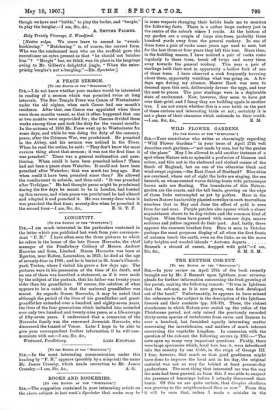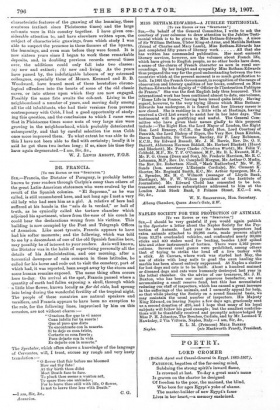THE KENTISH COB-NUT.
To vas Esrroa OP Tam "SPIZCSATOR."1 SrE,—In your review on April 27th of the book recently brought out by Mr. J. Bennett upon Ightham your reviewer pleads for further information concerning the fruit-growing of the parish, making the following remark: "It was in Ightbam that the cob-nut, as it is now grown, was first developed out of the hazel." Unfortunately, he appears to have missed the reference to the subject in the description of the Ightham fissures and their contents '(pp. 101-18). These, the richest storehonaes in which Nature ever sealed up the relics of the Pleistocene period, not only raised the previously recorded thirty-seven species of vertebrates from caves and fissures to over a hundred, but furnished equally interesting matter concerning the invertebrates, and matters of much interest concerning the vegetable kingdom. In connexion with the question of the cob-nut the following occurs (p. 105) :—" The nuts open up many very important questions. Firstly, there were large specimens which, local lore has it, were introduced into the country by one Cobb, in the reign of George III. I fear, however, that much as that good gentleman might have done to improve the local nut in his day, the original material TM not Bo very far behind at least present-day productions. The next thing that interested me was the way the nuts had been gnawed, as from this I was able to suspect the presence of lemmings before I actually discovered their bones. Of this we are quite certain, that Corylus alvellana was growing in the neighbourhood then as now." From thip it will be seen that, unless I made a mistake in the characteristic features of the gnawing of the lemming, these creatures (extinct since Pleistocene times) and the large cob-nuts were in this country together. I have given considerable attention to, and have elsewhere written upon, the subject of characteristic gnawings, from which study I was able to suspect the presence in these fissures of the hyaena, the lemmings, and even man before they were found. It is now sixteen years since I began to work these remarkable deposits, and, in doubling previous records several times over, the additions could only fall into two classes: (a) new and extinct; (b) new and • living. As the years have passed by, the indefatigable labours of my esteemed colleagues, especially those of Messrs. Kennard and B. B. Woodward, have traced most of these heretofore chronological offenders into the hearts of some of the old classic caves, or into others upon which they are now engaged. Possibly the same fate awaits the cob-nut. Living in the neighbourhood a number of years, and moving daily among all the old inhabitants, who had their versions from persons contemporary with Cobb, I had a good opportunity of studying this question, and the conclusions to which I came were that in Pleistocene times some nuts of very large size were growing in the neighbourhood, which probably deteriorated subsequently, and that by careful selection the man Cobb once more improved them. To what extent be was able to do this I have not been able to find with certainty ; locally it is said he got them two inches long; if so, since his time they have again degenerated.—I am, Sir, &c., W. J. LEWIS ABBOTT, F.G.S.







































 Previous page
Previous page